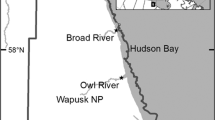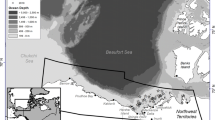Abstract
Relatively little is known about the feeding ecology of grizzly bears (Ursus arctos) in Wapusk National Park. Other ursids, polar bears (Ursus maritimus), are well known predators of waterfowl nests in the area, and grizzly bears could feasibly make use of such resources. However, since the arrival of polar bears on land in the spring is largely dependent on date of sea-ice breakup, the timing of predation by each bear species may differ. We investigated the timing of bear predation in common eider (Somateria mollissima sedentaria) and lesser snow goose (Anser caerulescens caerulescens) colonies from 2012 to 2018 using nest cameras. We observed grizzlies consuming eggs of both species in all years except 2013 and confirmed that at least two individual grizzlies occupied the park in 2016. In the 3 years when both grizzly and polar bears were detected, grizzlies were observed earlier in the year than polar bears and had greater overlap with an estimated availability index of incubating waterfowl. We hypothesize that grizzly bears could have earlier access to waterfowl eggs in the park, potentially reducing availability of these terrestrial foods to polar bears.




Similar content being viewed by others
References
Abraham KF, Mineau P, Cooke F (1977) Unusual predators of snow goose eggs. Can Field Nat 91:317–318
Alisauskas RT et al (2011) Harvest, survival, and abundance of midcontinent lesser snow geese relative to population reduction efforts. Wildl Monogr 179:1–42
Armstrong T (1998) Predation and antipredator tactics of nesting black brant and lesser snow geese. Unpublished PhD Thesis, University of Saskatchewan, Saskatoon
Atwood TC et al (2016) Rapid environmental change drives increased land use by an Arctic marine predator. PLoS ONE. https://doi.org/10.1371/journal.pone.0155932
Barry TW (1967) Geese of the Anderson River Delta. University of Alberta, Edmonton
Brook R, Kenkel N (2002) A multivariate approach to vegetation mapping of Manitoba’s Hudson Bay Lowlands. Int J Remote Sens 23:4761–4776
Cherry SG, Derocher AE, Thiemann GW, Lunn NJ (2013) Migration phenology and seasonal fidelity of an Arctic marine predator in relation to sea ice dynamics. J Anim Ecol 82:912–921
Clark D (2000) Notes—recent reports of Grizzly Bears, Ursus arctos, in northern Manitoba. Can Field Nat 114:692–693
Clark DA, Brook R, Oliphant-Reskanski C, Laforge MP, Olson K, Rivet D (2018) Novel range overlap of three ursids in the Canadian sub-Arctic. Arct Sci 5:62–70. https://doi.org/10.1139/as-2018-0013
Cooke F, Rockwell RF, Lank DB (1995) The snow geese of La Pérouse Bay: natural selection in the wild. Oxford ornithology series. Oxford University Press, Oxford
COSEWIC (2012) COSEWIC assessment and status report on the Grizzly Bear (Ursus arctos) in Canada. COSEWIC, Ottawa
COSEWIC (2017) COSEWIC assessment and status report on the Caribou Rangifer tarandus, Eastern Migratory population and Torngat Mountains population, in Canada, vol xvii. COSEWIC, Ottawa
Dey CJ, Richardson E, McGeachy D, Iverson SA, Gilchrist HG, Semeniuk CA (2017) Increasing nest predation will be insufficient to maintain polar bear body condition in the face of sea ice loss. Glob Change Biol 23:1821–1831
Doupé J, England J, Furze M, Paetkau D (2007) Most northerly observation of a grizzly bear (Ursus arctos) in Canada: photographic and DNA evidence from Melville Island, Northwest Territories. Arctic 60:271–276
Drent RH, Prop J (2008) Barnacle goose Branta leucopsis survey on Nordenskiöldkysten, west Spitsbergen 1975–2007: breeding in relation to carrying capacity and predator impact. Circumpolar Stud 4:59–83
Evans A et al (2016) Drivers of hibernation in the brown bear. Front Zool 70:1745–1754
Gau RJ, Case R, Penner DF, McLoughlin PD (2002) Feeding patterns of barren-ground grizzly bears in the central Canadian Arctic. Arctic 55:339–344
Gormezano LJ, Ellis-Felege SN, Iles DT, Barnas A, Rockwell RF (2017) Polar bear foraging behavior during the ice-free period in Western Hudson Bay: observations, origins, and potential significance. Am Mus Novit 1–28
Gormezano LJ, McWilliams SR, Iles DT, Rockwell RF (2016) Costs of locomotion in polar bears: when do the costs outweigh the benefits of chasing down terrestrial prey? Conserv Physiol 4:1–9
Gormezano LJ, Rockwell RF (2015) The energetic value of land-based foods in Western Hudson Bay and their potential to alleviate energy deficits of starving adult male polar bears. PLoS ONE 10:e0128520
Grolemund G, Wickham H (2011) Dates and times made easy with lubridate. J Stat Softw 40:1–25
Iles DT, Rockwell RF, Matulonis P, Robertson GJ, Abraham KF, Davies JC, Koons DN (2013) Predators, alternative prey and climate influence annual breeding success of a long-lived sea duck. J Anim Ecol 82:683–693
Iverson SA, Gilchrist HG, Smith PA, Gaston AJ, Forbes MR (2014) Longer ice-free seasons increase the risk of nest depredation by polar bears for colonial breeding birds in the Canadian Arctic. Proc R Soc Lond B 281:20133128
Johnson SR, Noel LE (2005) Temperature and predation effects on abundance and distribution of Lesser Snow Geese in the Sagavanirktok River Delta, Alaska. Waterbirds 28:292–300
Kerbes RH, Prairie CWS, Region N (2006) Surveys of nesting mid-continent lesser snow geese and Ross’s geese in eastern and central Arctic Canada, 1997–98. Technical Report Series No. 447. Canadian Wildlife Service, Prairie and Northern Region, Saskatoon
Lunn N, Stirling I (1985) The significance of supplemental food to polar bears during the ice-free period of Hudson Bay. Can J Zool 63:2291–2297
McLoughlin PD, Case RL, Gau RJ, Cluff DH, Mulders R, Messier F (2002) Hierarchical habitat selection by barren-ground grizzly bears in the central Canadian Arctic. Oecologia 132:102–108
Miller S, Wilder J, Wilson RR (2015) Polar bear–grizzly bear interactions during the autumn open-water period in Alaska. J Mammal 96:1317–1325
Obst J, Hines JE, Dufour J-F, Woodard PF, Bromley RGH (2013) Habitat conditions, grizzly bear predation of nests, and spring use of the Anderson River delta by Lesser Snow Geese and Brant, 2005–2006. Technical Report Series No. 523. Canadian Wildlife Service, Prairie and Northern Region, Saskatoon
Pigeon KE, Stenhouse G, Côté SD (2016) Drivers of hibernation: linking food and weather to denning behaviour of grizzly bears. Behav Ecol Sociobiol 70:1745–1754
Pongracz JD, Paetkau D, Branigan M, Richardson E (2017) Recent hybridization between a polar bear and grizzly bears in the Canadian Arctic. Arctic 70:151–160
Prop J, Oudman T, van Spanje TM, Wolters EH (2013) Patterns of predation of Pink-footed Goose nests by polar bear. Ornis Norvegica 36:38–46
R Core Team (2017) R: a language and environment for statistical computing. R Foundation for Statistical Computing, Vienna. https://www.r-projectorg/
Regehr EV, Lunn NJ, Amstrup SC, Stirling I (2007) Effects of earlier sea ice breakup on survival and population size of polar bears in Western Hudson Bay. J Wildl Manag 71:2673–2683
Richardson E, Stirling I, Hik DS (2005) Polar bear (Ursus maritimus) maternity denning habitat in Western Hudson Bay: a bottom-up approach to resource selection functions. Can J Zool 83:860–870
Richardson TW, Gardali T, Jenkins SH (2009) Review and meta-analysis of camera effects on avian nest success. J Wildl Manag 73:287–293
Rockwell R, Gormezano L (2009) The early bear gets the goose: climate change, polar bears and lesser snow geese in Western Hudson Bay. Polar Biol 32:539–547
Rockwell R, Gormezano L, Hedman D (2008) Grizzly bears, Ursus arctos, in Wapusk National Park, Northeastern Manitoba. Can Field Nat 122:323–326
Rockwell RF et al (2009) The birds of Wapusk National Park. Wapusk National Park of Canada Occasional Paper 1, pp 1–47
Rockwell RF, Gormezano LJ, Koons DN (2011) Trophic matches and mismatches: can polar bears reduce the abundance of nesting snow geese in Western Hudson Bay? Oikos 120:696–709
Rode KD, Amstrup SC, Regehr EV (2010) Reduced body size and cub recruitment in polar bears associated with sea ice decline. Ecol Appl 20:768–782
Rode KD, Robbins CT, Nelson L, Amstrup SC (2015a) Can polar bears use terrestrial foods to offset lost ice-based hunting opportunities? Front Ecol Environ 13:138–145
Rode KD, Wilson RR, Regehr EV, Martin MS, Douglas DC, Olson J (2015b) Increased land use by Chukchi Sea polar bears in relation to changing sea ice conditions. PLoS ONE 10:e0142213
Shilts WW, Aylsworth JM, Kaszycki CA, Klassen RA (1987) Canadian shield. Geomorphic systems of North America, vol 2. Geological Society of America, Boulder, pp 119–161
Smith PA, Elliott KH, Gaston AJ, Gilchrist HG (2010) Has early ice clearance increased predation on breeding birds by polar bears? Polar Biol 33:1149–1153
Stempniewicz L (2006) Polar bear predatory behaviour toward molting barnacle geese and nesting glaucous gulls on Spitsbergen. Arctic 59:247–251
Stern HL, Laidre KL (2016) Sea-ice indicators of polar bear habitat. Cryosphere 10:2027–2041
Stirling I, Derocher AE (2012) Effects of climate warming on polar bears: a review of the evidence. Glob Change Biol 18:2694–2706
Stirling I, Lunn NJ, Iacozza J (1999) Long-term trends in the population ecology of polar bears in Western Hudson Bay in relation to climatic change. Arctic 52:294–306
Taylor M (1995) Grizzly bear sightings in Viscount Melville Sound. In: Wiig Ø, Born E, Garner EW (eds) Proceedings of the eleventh working meeting of the IUCN/SSC Polar Bear Specialist Group. IUCN, Gland, pp 191–192
Weller MW (1956) A simple field candler for waterfowl eggs. J Wildl Manag 20:111–113
Westerskov K (1950) Methods for determining the age of game bird eggs. J Wildl Manag 14:56–67
Acknowledgements
Funding was generously provided by the National Science Foundation (#13197000 awarded to SNE), North Dakota EPSCoR Infrastructure Improvement Program-Doctoral Dissertation Assistantship #OIA-1355466, Wapusk National Park, Arctic Goose Joint Venture, the Central and Mississippi Flyway Councils, the National Geographic Society, North Dakota View Scholarship, UND College of Arts and Sciences, and UND Biology Department. DTI received funding for this work from Ducks Unlimited Canada, Delta Waterfowl, and the California Waterfowl Association. Permissions and in-kind assistance were provided by Parks Canada, Wapusk National Park Management Board, and the Community of Churchill, Manitoba. Wapusk National Park provided us with the mapping files for the construction of Fig. 1, while the Canadian provinces and territories layer was accessed via ESRI online. We are grateful for flight coordination and logistic support from Hudson Bay Helicopters. We thank Heather Slinn for comments on an early draft of this manuscript, as well as the constructive feedback from the Polar Biology Editor-in-Chief Dieter Piepenburg and three reviewers: Dr. Karyn Rode, Dr. Aimee Tallian, and one anonymous reviewer. This work would not have been possible without assistance in the field and image review by technicians who are too numerous to name here.
Author information
Authors and Affiliations
Corresponding author
Ethics declarations
Conflicts of interest
The authors have no conflicts of interest or competing interests to declare. Data collection in Wapusk was authorized by Wapusk National Park Permits: WAP-2012-11199, WAP-2015-18760, WAP-2018-27940, WAP 2013-13534, and WAP-2016-2149; Canadian Wildlife Services Permits: 11-MB-SC001 and 16-MB-SC001; Utah State University IACUC Protocols 2208 and 2018, University of North Dakota IACUC approvals #A3917-01 and Protocols 1505-10, 1601-2, and 1801-3C.
Additional information
Publisher's Note
Springer Nature remains neutral with regard to jurisdictional claims in published maps and institutional affiliations.
Electronic supplementary material
Below is the link to the electronic supplementary material.
Rights and permissions
About this article
Cite this article
Barnas, A.F., Iles, D.T., Stechmann, T.J. et al. A phenological comparison of grizzly (Ursus arctos) and polar bears (Ursus maritimus) as waterfowl nest predators in Wapusk National Park. Polar Biol 43, 457–465 (2020). https://doi.org/10.1007/s00300-020-02647-w
Received:
Revised:
Accepted:
Published:
Issue Date:
DOI: https://doi.org/10.1007/s00300-020-02647-w




